Support at Home Program:
Everything You Need to Know
CONTENTS
Jump to the section you need
- Introduction to SAH
- What is the SAH Program?
- What’s Changed?
- Where You Fit? New
- Transitioned HCP Classifications New
- What if I already have a Home Care Package?
- Home Care Package vs Support at Home
- New Support at Home Categories
- New Short Term Pathways
- New Support at Home Levels
- How to Access Support at Home
- Eligibility Criteria
- Fees & Contributions
- Choosing the Right Provider
- FAQs
- Support At Home Resources
- Support At Home Guide New
New Support at Home Program Launched November 1, 2025
From 1 November 2025, the Australian Government introduced the Support at Home Program, a new way of delivering aged care services to help older Australians live independently, safely, and comfortably in their own homes.
This program is part of the national aged care reform and will replace existing home support systems, creating a simpler, fairer, and more flexible approach to care.
If you or a loved one currently receive home care, or you’re exploring options for the future, this guide explains everything you need to know about the upcoming program.
Last Updated: 09/12/2025
What is the Support at Home Program?
The Support at Home program is part of the Australian Government’s plan to improve in-home aged care, helping older people live independently at home for longer.
This new model was developed following the Royal Commission into Aged Care, which identified gaps in the industry that needed to be addressed.
Support at Home is designed to:
- Provide simpler access to in-home aged care services
- Offer greater flexibility to tailor support to individual needs
- Ensure consistency and fairness across the system
- Strengthen quality and safety standards for older Australians


What’s changing with Support at Home Packages?
From 1 November 2025, Support at Home replaced the Home Care Packages Program and the Short-Term Restorative Care (STRC) Program. The Commonwealth Home Support Program (CHSP) will transition into Support at Home no earlier than 1 July 2027.
The program gives older Australians easier access to services, equipment and home modifications that support their health, independence and community connections.
Includes:
- Restorative Care Pathway – multidisciplinary allied health services to maintain and improve independence.
- Assistive Technology and Home Modifications (AT-HM) Scheme – funding for products, equipment and home modifications to meet assessed needs.
- End-of-Life Pathway – dedicated funding to support people to remain at home in their last three months of life.
In short, Support at Home aims to create a more transparent, responsive and person-centred aged care system, making it easier for older Australians and their families to navigate and receive the care they need.
Support at Home Transition Dates
& Where You Fit
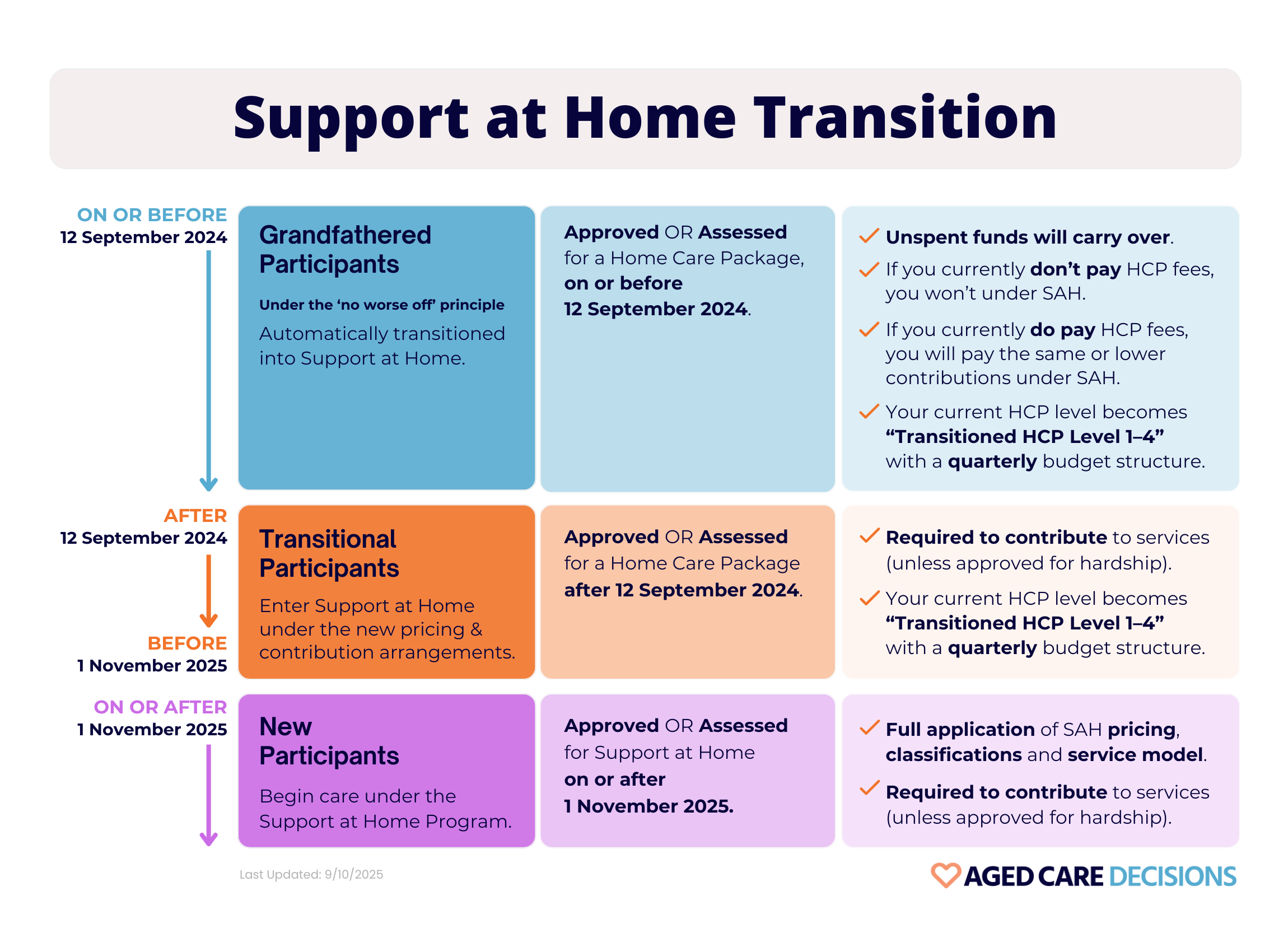
If You’re Transitioning from a Home Care Package
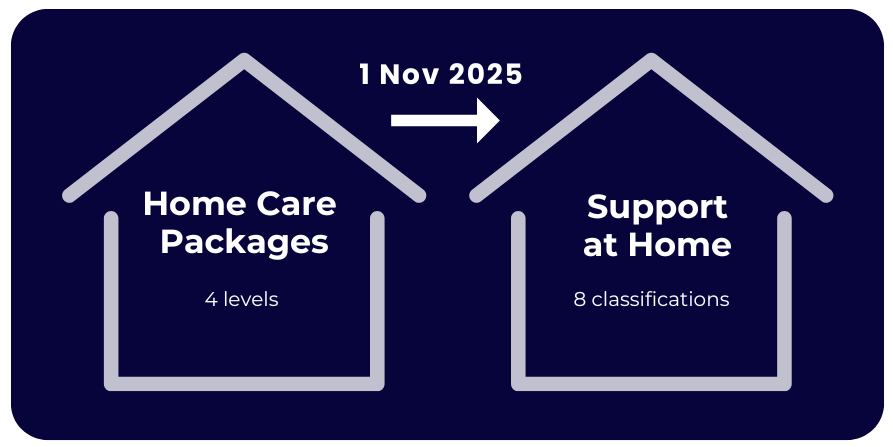
Grandfathered Participants
If you were assessed or approved for a Home Care Package on or before 12 September 2024, you will be grandfathered into the new Support at Home program on 1 November 2025. You will be covered by the ‘no worse off’ principle, meaning your contribution costs will stay the same or be lower.
You will automatically transition to the new program without needing to reapply or undergo reassessment. You will retain your existing package level and any unspent Home Care Package funds, which can continue to be used for services available under Support at Home, including assistive technology and home modifications where appropriate.
There are transitional classifications for HCP recipients: for example, an HCP Level 1 becomes “Transitioned HCP Level 1” under Support at Home, with a defined quarterly and annual budget.
‘No worse off’ Principle
If you were assessed or approved for a Home Care Package on or before 12 September 2024, you will be covered by the ‘no worse off’ principle. Your contribution costs will stay the same or be lower:
- If you don’t pay fees for your Home Care Package,
you will never pay fees for Support at Home, even
if you are re-assessed to a higher classification. - If you do pay fees for your Home Care Package, you
will pay the same or lower under Support at Home. - The $82,018 lifetime cap (indexed) remains in place.
National Priority System
If you are on the National Priority System awaiting a Home Care Package, you will move to the Support at Home Priority System. Your budget will be allocated once a place becomes available, and it will match your assessed HCP funding. A new assessment is only required if your care needs change.
Service Prices May Differ
Service prices may differ under Support at Home, but government protections ensure costs are fair and transparent. Providers will communicate any changes to your in-home care arrangements ahead of time. The Department of Health, Disability and Ageing is working closely with providers to make the transition as smooth as possible and minimise any impact on your care.
Transitioned Home Care Packages Classifications
Existing Home Care Package (HCP) participants before 1 November 2025 will maintain their current funding when they move to the Support at Home program. Each person will be assigned a corresponding Transitioned HCP Level 1, 2, 3 or 4, with the same annual funding provided on a quarterly basis. From 1 November 2025, new participants in Support at Home will be assessed under the new eight classifications.
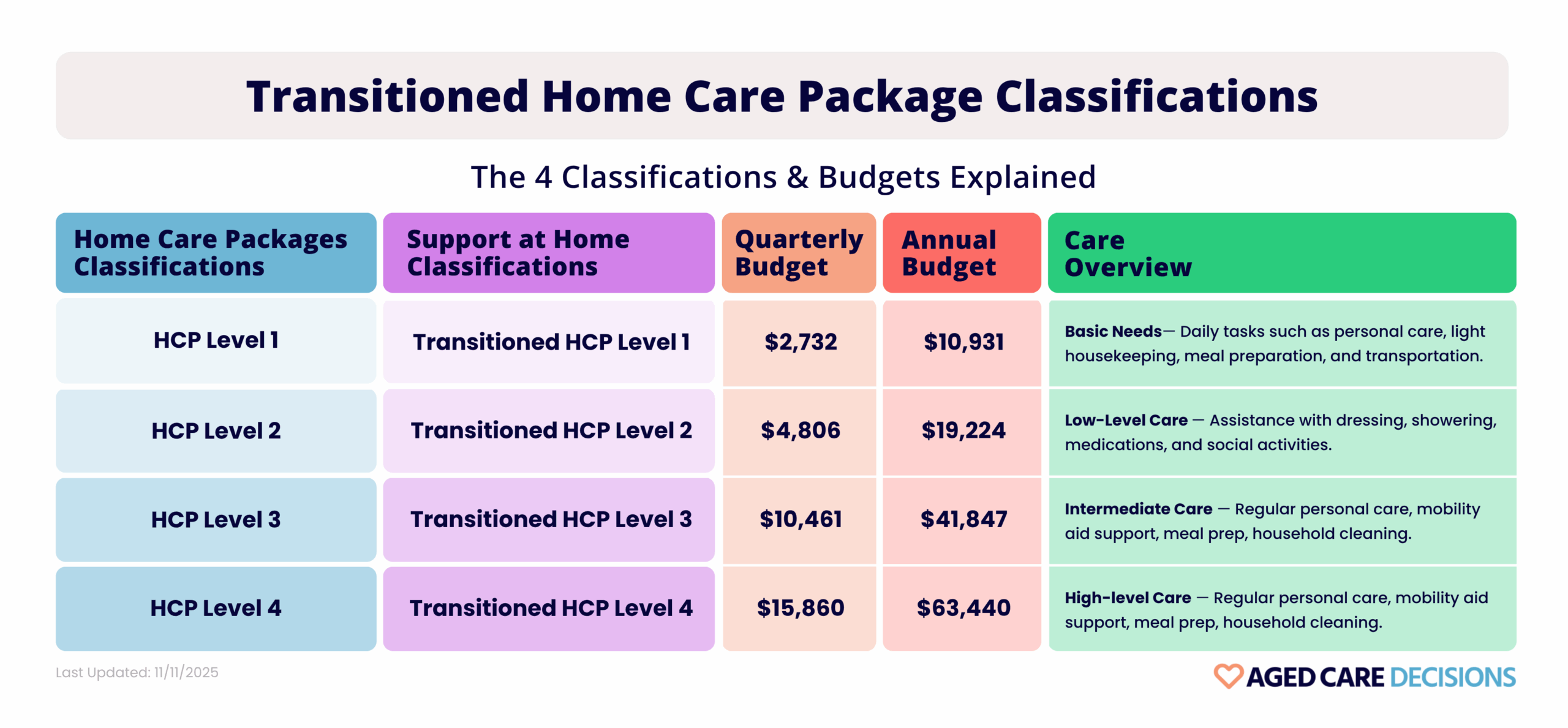
The Support at Home Program is designed to bring together multiple home support programs into one streamlined system. Its goal is to reduce confusion, cut red tape, and give older Australians more choice and control over the services they receive.
Home Care Packages (HCP)
Home Care Packages (HCP) cater to older Australians who need long-term support to live independently at home. They offer four levels of care, providing services such as personal care, domestic assistance, nursing, and allied health, based on each person’s specific needs.
Support At Home (SAH)
Designed to deliver flexible funding and high-quality care, this program will replace the existing Home Care Packages (HCP) and Short-Term Restorative Care (STRC) programs from November 1, 2025. It introduces eight classifications of tailored support, allowing for a more individualised approach to care.
Learn more: Home Care Package vs Support at Home
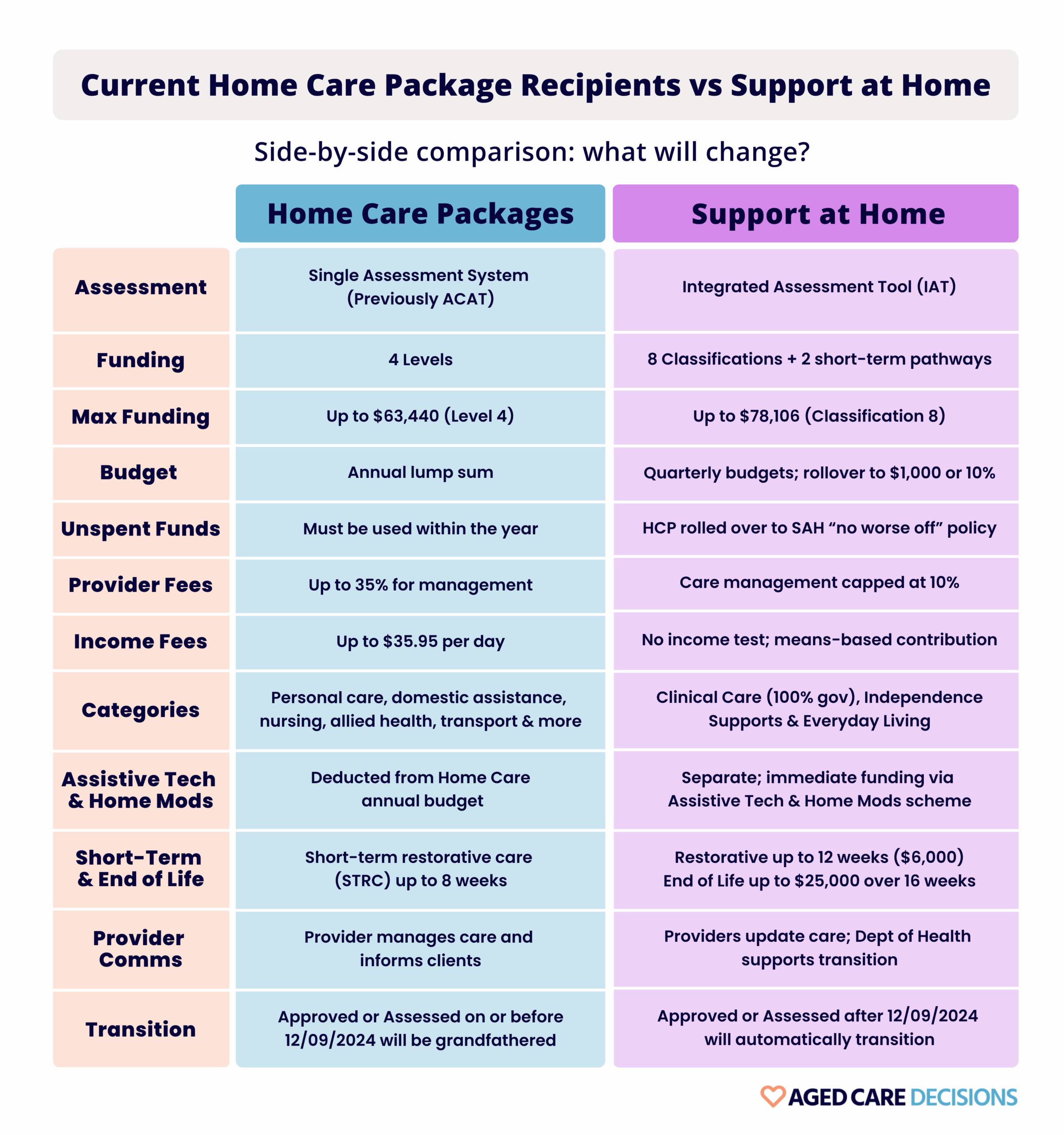
The 3 New Support at Home Categories
Support at Home provides funding for services that help seniors stay safe, healthy, and independent in their own homes. The program covers medical care, everyday living assistance, and social support, ensuring older Australians can maintain their quality of life while staying connected to their communities.
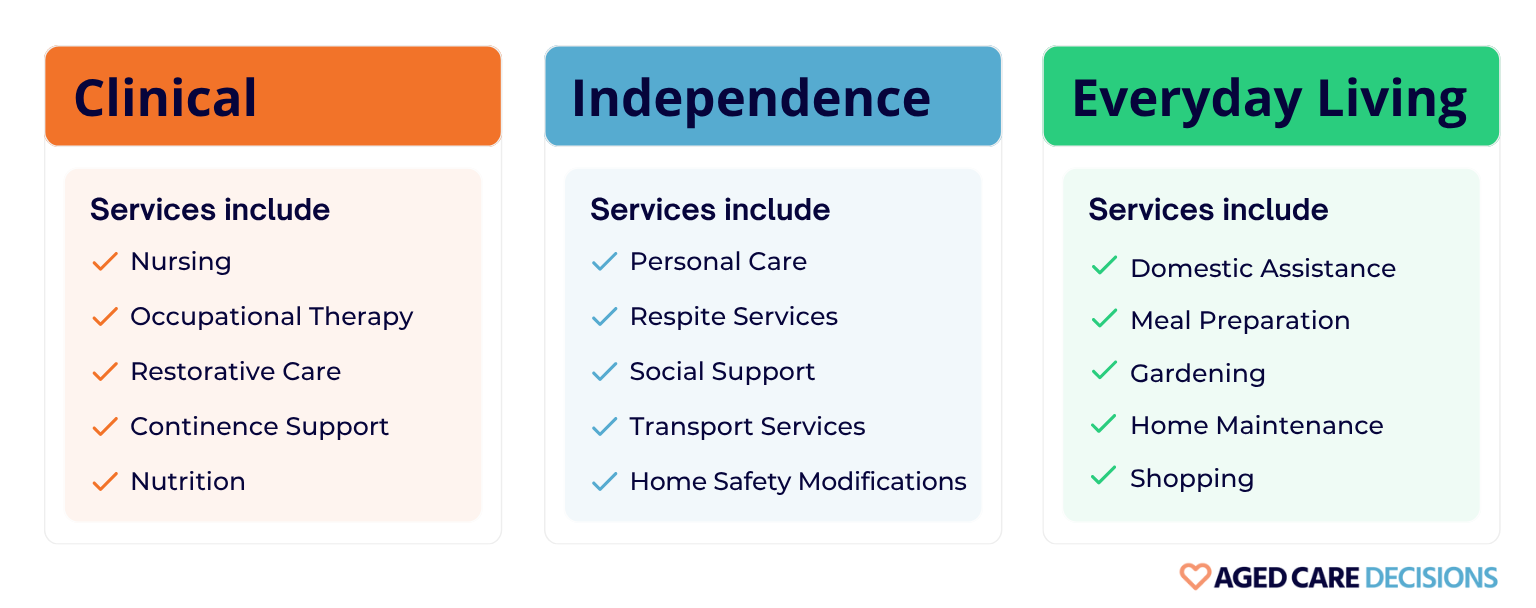
The Support at Home Categories Explained
Clinical Care
This category is fully funded by the government and covers essential medical and health services. It includes nursing (like wound care, medication management, and chronic disease support), allied health services (physiotherapy, occupational therapy, psychology, and more), continence support, and nutritional management.
Clinical care ensures seniors receive the professional medical support they need to stay healthy at home.
Independence Support
These services help seniors maintain daily independence and social connections, though some costs may apply depending on income and pension status. Services include personal care (showering, dressing, toileting, and eating), social support (companionship, group outings, and technology assistance), therapeutic services (massage, acupuncture, art therapy, etc.), short-term respite care, and transport options.
Independence support helps seniors live safely and actively while remaining connected to their communities.
Everyday Living
This category covers practical help to keep a home safe and functional. Services include domestic assistance (cleaning, laundry, errands), meal preparation, minor home maintenance, and gardening. It also includes funding for assistive technology (wheelchairs, walking aids, smart home devices) and home modifications (ramps, handrails, accessible bathrooms).
Special programs, like restorative care and end-of-life care, provide extra support for recovery or staying at home in later stages of life.
The 2 New Short-Term Pathways
Restorative Care Pathway
The Restorative Care Pathway helps seniors regain independence with daily activities, supporting them to continue enjoying the things they love and potentially reducing the need for additional services.
Through this program, you can:
- Access up to 12 weeks of restorative care.
- Receive an extra budget of around $6,000 (or up to $12,000 if needed) for allied health services.
- Use restorative care on its own or alongside your ongoing Support at Home services.
- Access assistive technology and home modifications through the Assistive Technology and Home Modifications (AT-HM) scheme if required.
Learn more about the new Restorative Care Pathway and and how it can support your independence, wellbeing, and access to essential aged care services.
End-of-Life Pathway
The End-of-Life Pathway helps seniors remain at home during their final three months of life. You can be referred for a high-priority Support Plan Review to access this pathway, even if you are not currently receiving Support at Home.
- Access urgent, higher-level funding for in-home aged care services if diagnosed with three months or less to live.
- Use assistive technology through the Assistive Technology and Home Modifications (AT-HM) scheme if needed.
- Receive up to $25,000 in funding over 12 weeks, with up to 16 weeks to use the funds for flexibility.
If additional services are needed beyond 12 weeks, an assessment can be requested to continue receiving Support at Home services. This pathway complements other in-home palliative care provided by state and territory governments.
You can also learn more about Support at Home’s End-of-Life Pathway here.
Support At Home Classifications

The 8 Classifications & Budgets
The shift from four Home Care Package levels to eight Support at Home Classifications reflects the government’s commitment to tailoring services more precisely to individual care needs. By offering more detailed tiers, the program better aligns funding and services with a person’s evolving health, mobility, and daily living challenges.
These eight classifications bridge the gap between basic assistance and complex in-home care, ensuring that Australians receive the right type of support at the right time, reducing risks of hospitalisation and premature entry into residential care.
Each classification comes with a defined budget, allocated quarterly and annually, allowing recipients to access approved services tailored to their care needs.
Below is an overview of the types of care typically provided at each Support at Home Classification, alongside the indicative annual funding amounts.
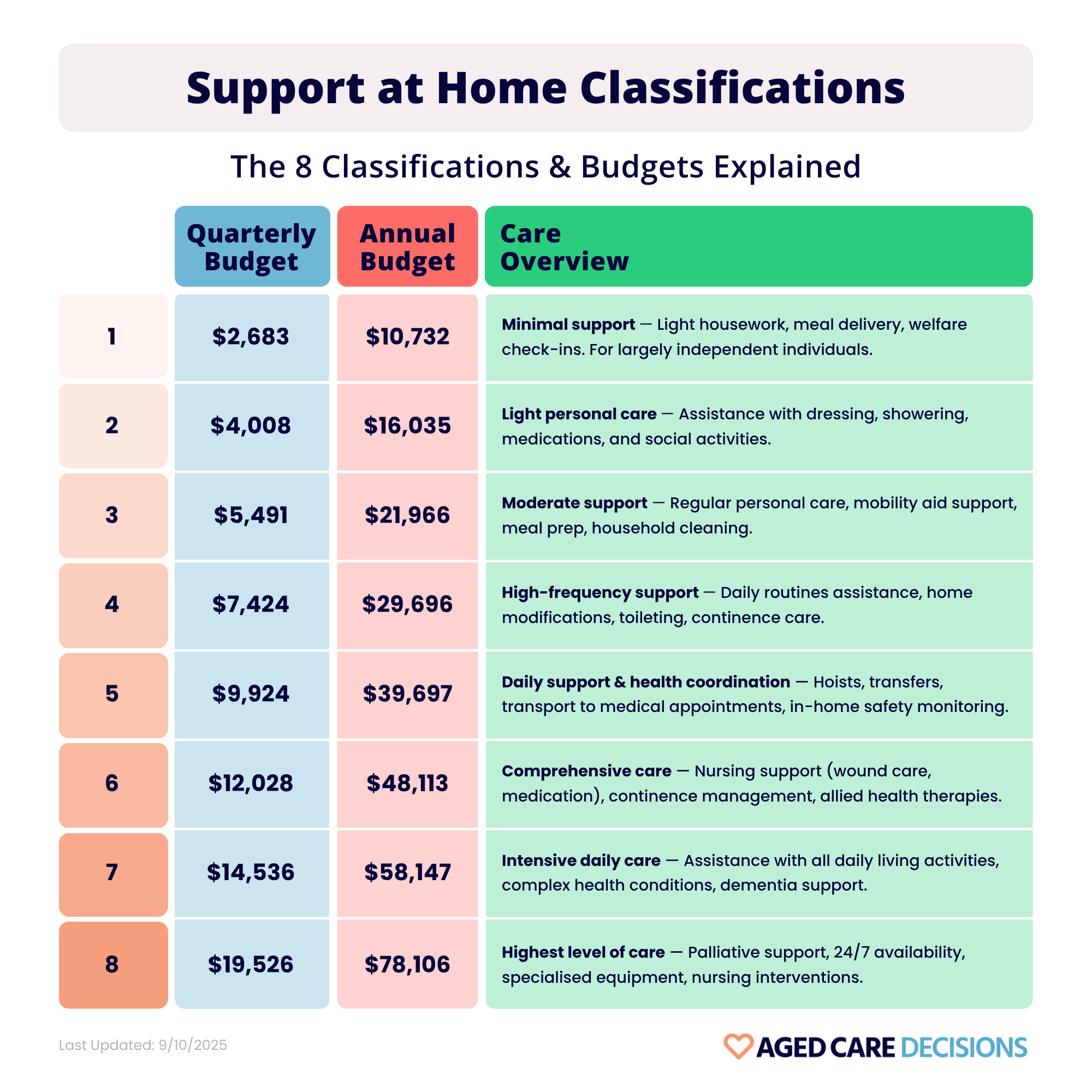
How do I Apply for
Support at Home?
The Single Assessment System was created to make it easier for older people to access aged care services as their needs change.
If you are not already receiving services through My Aged Care, the first step is to check your eligibility for an assessment. You can do this online at My Aged Care or by calling 1800 200 422.
If your application is successful, you will be referred for an in-person assessment at your home
Once assessed and found eligible for the Support at Home program, you will receive a Notice of Decision along with an individual support plan to share with your provider.
Your Support At Home Plan Includes:
- A summary of your aged care needs and goals.
- Your classification, along with the associated ongoing quarterly budget and a list of your approved services.
- Any short-term support approvals, which may include funding for:
– Assistive Technology
– Home Modifications
– Restorative Care Pathway
– End-of-Life Pathway
Support at Home
Eligibility Criteria
To be eligible for a Support at Home assessment, you generally need to:
- Be aged 65 years or older (or 50 years or older if you’re an Aboriginal or Torres Strait Islander person).
- Have difficulty managing everyday tasks due to age-related factors.
- Require support to remain living independently at home.
These criteria are assessed through a two-part process:
1
Eligibility Check
You can complete an online eligibility check on the My Aged Care website or call My Aged Care at 1800 200 422.
2
In-Person Assessment
If eligible, an assessor will visit your home to evaluate your needs and discuss suitable services.
Support at Home Eligibility Criteria
- Be aged 65 years or older (or 50 years or older if you’re an Aboriginal or Torres Strait Islander person).
- Have difficulty managing everyday tasks due to age-related factors.
- Require support to remain living independently at home.
These criteria are assessed through a two-part process:
1
Eligibility Check
2
In-Person Assessment
Support at Home Standard
Fees & Contributions
Approved or Assessed for a Home Care Package
AFTER 12 September 2024
From 1 November 2025, participants that were Approved or Assessed a Home Care Package after 12 September 2024 will receive services through the new Support at Home program under the standard fees and contributions model. These participants will not be covered by the grandfathering arrangements and will instead enter the program under the new fee structure for Support at Home.
Under the new arrangements, clinical care services will be fully funded by the government for all participants. Contributions toward independence and everyday living supports will be income-based. Self-funded retirees pay the highest contributions; those eligible for a Commonwealth Seniors Health Card (CSHC) pay lower rates, similar to part pensioners. There is a lifetime contributions cap of $130,000 for non-clinical services under Support at Home.
Learn more: Support at Home Fees & Contributions
Source: Support at Home participant contributions
Full Pensioners
Clinical care is fully covered - pay 0%
Independence supports - pay up to 5%
Everyday living services - pay up to 17.5%
Part Pensioners
Clinical care is fully covered - pay 0%
Independence supports - pay 5-50%
Everyday living services - pay 17.5-80%
Self-Funded Retirees
Clinical care is fully covered - pay 0%
Independence supports - pay up to 50%
Everyday living services - pay up to 80%
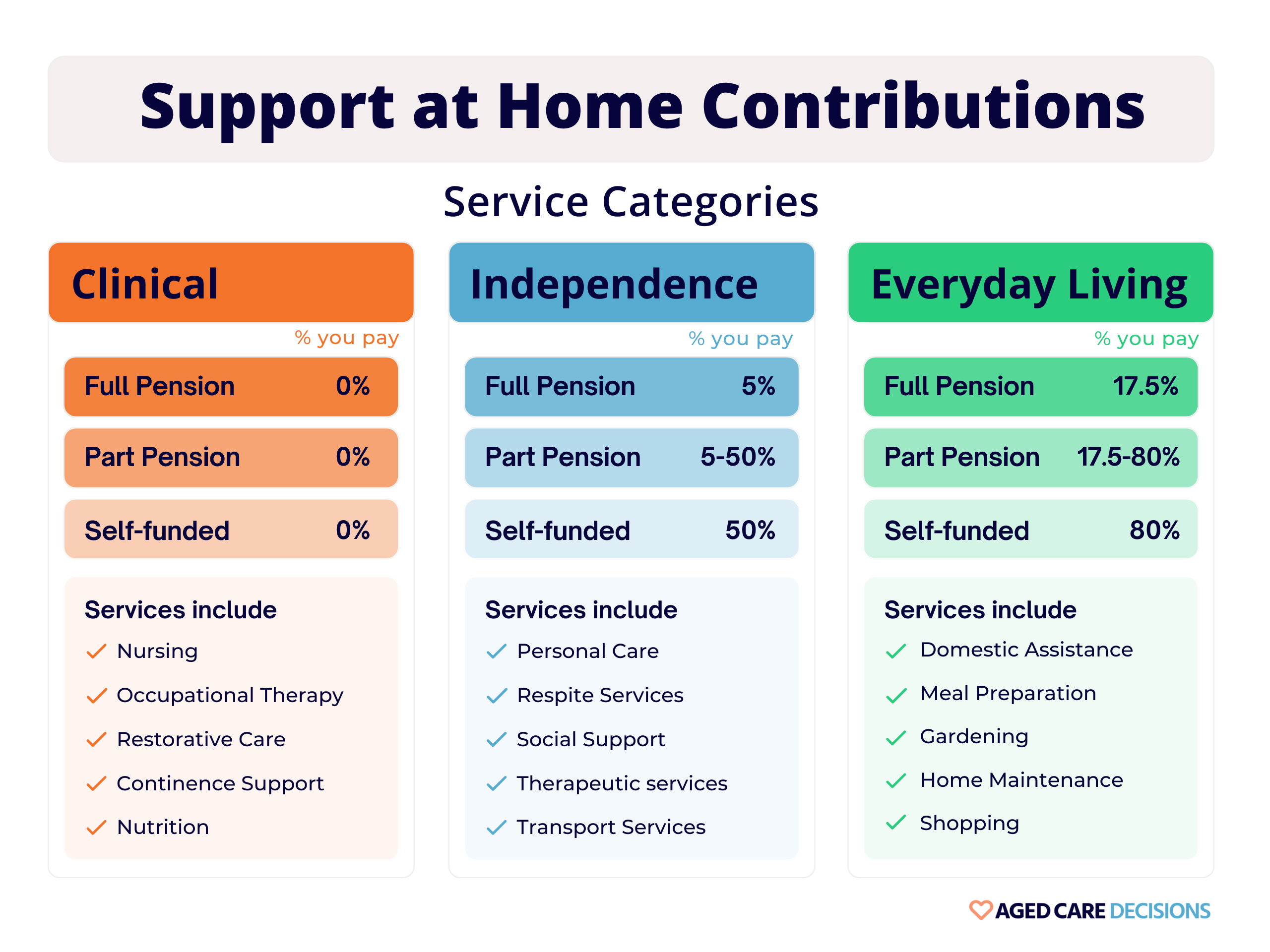
Support at Home Grandfathered
Fees & Contributions
Approved or Assessed for a Home Care Package on or
BEFORE 12 September 2024
If you are transitioning from the Home Care Packages Program, anyone who was receiving a package or assessed for a home care package on or before 12 September 2024 will be no worse off under Support at Home. You will pay the same contributions, or lower, than you were assessed to pay under HCP.
If you were assessed as not required to pay fees before that date, you will never be asked to pay fees under Support at Home. The HCP lifetime cap of $82,018 (indexed) will continue to apply. Contributions may still change over time if your assessed care needs or financial circumstances change, when indexation applies to fees and thresholds, or once you reach your lifetime cap. Routine indexation occurs on 20 March and 20 September each year.
Learn more: Support at Home Fees & Contributions
Source: Support at Home participant contributions
Grandfathered
Full Pensioners
Clinical care is fully covered - pay 0%
Independence supports - pay 0%
Everyday living services - pay 0%
Grandfathered
Part Pensioners
Clinical care is fully covered - pay 0%
Independence supports - pay between 0-25%
Everyday living services - pay between 0-25%
Grandfathered
Self-Funded Retirees
Clinical care is fully covered - pay 0%
Independence supports - pay up to 25%
Everyday living services - pay up to 25%
*No worse off principle- If you were assessed as not having to pay fees for your Home Care Package on or before 12 September 2024, you will never pay fees on Support at Home. (source)
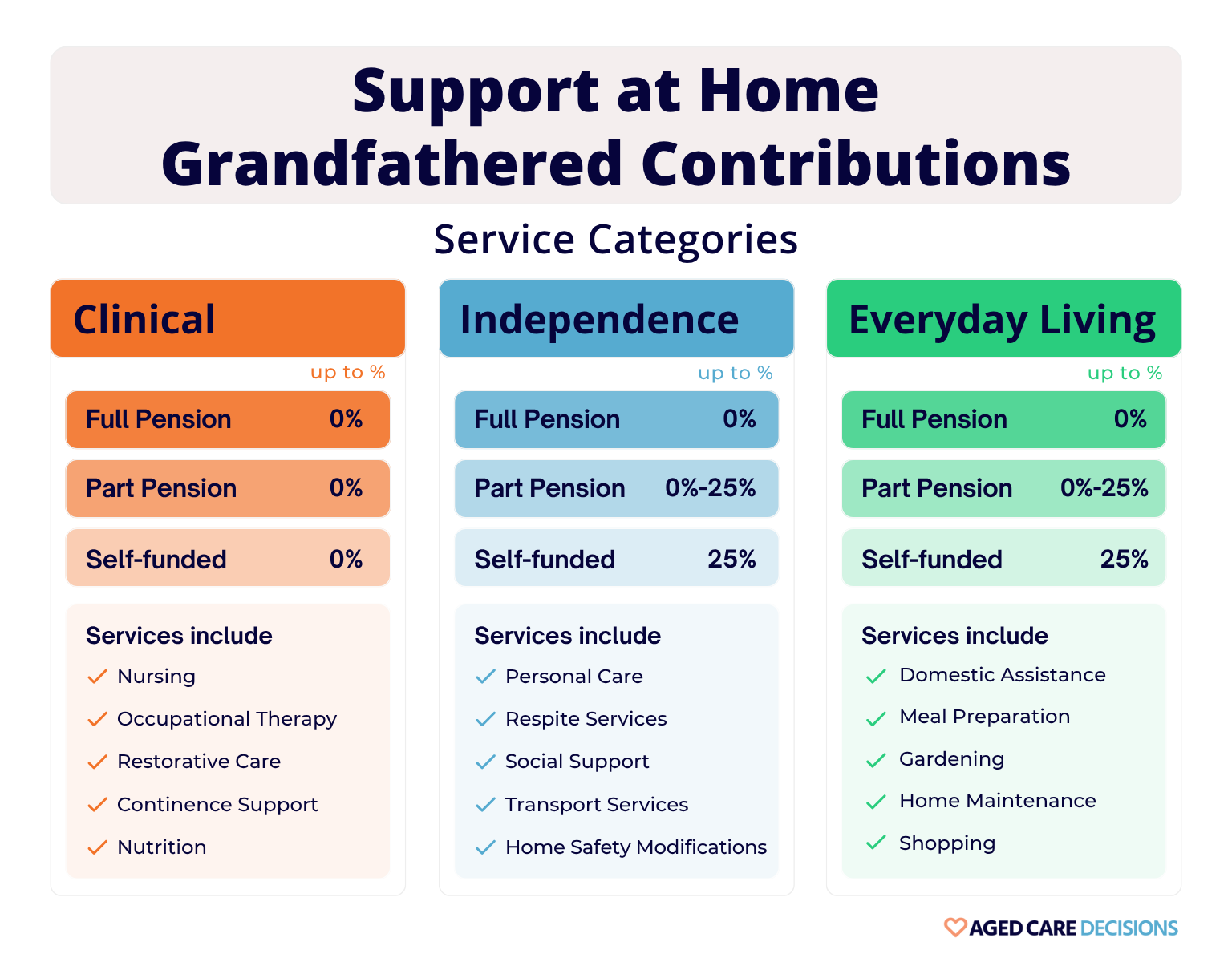
How Aged Care Decisions can support you?
Finding the right Support at Home provider doesn’t have to be complicated. Aged Care Decisions (ACD) helps you navigate your options, match your needs with approved providers, and make informed choices with confidence. Start today and take control of your home care journey.
Choosing the Right Support at Home Provider

Understanding your care needs
Our friendly team will ask you a few questions about your individual care needs, location, preferences, and budget so we know how we can assist you in your Support at Home journey.
Unlimited 1 on 1 support
Unlimited 1 on 1 support from your designated Placement Specialist. We provide you with the most up to date Support at Home resources. We assist at every stage of your Support at Home journey.
Customised options list
Receive a customised options list of Support at Home Providers matched to your individual care needs. We match you or your loved one with in-home care services that can provide the in-home care you need.
ACD assist tens of thousands of families each month
Shirl B.
“We spoke with ACD yesterday and they were very helpful to clear assisting us to find an alternative home care provider. Nothing was too much trouble and we know that the next provider we choose will be up to the job with well trained staff. Thank you.”
Jeanette W.
“Hardest decision of my life is putting my mum in care. So helpful and understanding of what I wanted for her and sent everything within minutes I asked for. Thank you.”
Andrea S.
“Aged Care Decisions were very helpful in providing Home Care Package providers in my area, and followed up to make sure that the whole process was going well. Highly recommended!”
Support at Home FAQ's
What is the Support at Home program?
A single, government-funded in-home aged-care program that replaces the Home Care Packages (HCP) and Short-Term Restorative Care programs to deliver assessed in-home supports and clinical services.
When does it start and what happens to existing Home Care Packages?
Support at Home commences 1 November 2025. Existing HCP recipients will be transitioned and can discuss the move with their provider; funding equivalence is maintained during transition
How much will I pay for my home care?
Access is via My Aged Care (Single Assessment System). Assessment outcome assigns a classification and an approved support plan; then you choose a registered provider. This mirrors HCP entry steps, but uses the new classification system.
Who is eligible for Support at Home?
To be eligible for Support at Home you must be:
- aged 65 years or over (50 years or older for Aboriginal and Torres Strait Islander people)
- living at home (not in residential aged care)
- an Australian citizen or permanent resident
- assessed by My Aged Care as someone who needs home care services.
You can quickly check if you’re eligible using My Aged Care’s online eligibility checker.
What happens during the Support at Home assessment?
A member of the My Aged Care assessment team, usually a nurse, social worker, or health care professional, will visit you in your home. They’ll look at the way you manage day-to-day activities and speak with you about what aged care services will be best to help you. The assessment usually takes between 1-3 hours.
Read more: How to prepare for an aged care assessment
How long will it take to get home care services?
Wait times are generally between 3-6 months but can be as long as 12 months, depending on national demand. You can check the progress of your application or assessment by calling My Aged Care on 1800 200 422 or by logging into your My Aged Care online account.
Read more: My Aged Care Online Account | A Simple Guide
What services can be funded?
Support at Home uses a defined service list across Clinical Supports, Independence, and Everyday Living (examples: nursing, allied health, personal care, domestic assistance, transport, home modifications). Clinical services are explicitly listed as fundable.
How are levels and funding structured under Support at Home?
There are 8 ongoing classifications. Each classification has a defined quarterly budget aligned to assessed needs (replacing the HCP four-level model).
Can I buy big ticket items with my Support at Home budget?
Yes. You can use your budget to pay for bigger items like home modifications or a mobility scooter. Your home care provider will work with you to make sure your budget covers what you need. You can also carry over up to $1,000 or 10% of your allocation (whichever is greater) from one quarter to the next.
What will participants have to pay?
Participants will make contributions for Independence and Everyday Living services; clinical services are not subject to participant contributions. The program includes rules on contribution rates, a lifetime cap, no-worse-off protections and financial hardship support.
How much will I pay for my home care?
Support at Home will divide services into three categories, each with different out-of-pocket costs.
- Clinical care: the government will cover 100% of the cost of nursing and allied health services.
- Independence: you will pay between 5%-50% of the cost of personal care, social support services and home modifications.
- Daily living: you will pay between 17.5%-80% for domestic assistance, meal preparation and help with shopping.
Please note: The percentage you’ll pay for Independence and Daily Living service categories will depend on your financial status — whether you receive a full pension, a part pension, or are self-funded. In addition, Each provider sets their own price for services.
Read more: Understanding contributions for the new Support at Home program
What happens if my care needs change?
Your home care needs will naturally evolve over time. As they do, your home care provider should work with you evaluate and adjust the combination of services you receive. If your care needs increase significantly your My Aged Care assessor may increase your Support at Home classification so you can receive more funding.
What happens if I already have a Home Care Package?
If you have a Home Care Package you will automatically transfer to the Support at Home program on 1 November 2025. You will not need a new assessment unless your needs have changed, and you wish to apply for increased support.
The funding you receive as part of your Home Care Package will remain the same. Any unspent Home Care Package budget will carry over to your Support at Home account.
Your current provider will continue to deliver care under the new program, and you should not experience a “gap” in services.
If I’m on CHSP, will I switch to Support at Home?
The Commonwealth Home Support Program will merge with Support at Home no earlier than 1 July 2027. Until then, there will be no changes to the way your home care services are funded and delivered.
Read more: What is CHSP | The Commonwealth Home Support Program
What happens if I’m on the waiting list for a Home Care package?
If you’ve been assessed for a Home Care Package and are on the National Priority System (waiting list) before 1 November 2025, you will join Support at Home when a place becomes available.
Your Support at Home budget will match the budget of the Home Care Package level you were approved for. You will not need to have a new assessment to get Support at Home.
How can I get urgent homecare support if I need it?
If you’re waiting for Support at Home but need urgent care, your application may be fast-tracked. Contact My Aged Care on 1800 200 422 to find out whether this option applies to your circumstances.
You can also apply to access temporary services through the Commonwealth Home Support Program. Alternatively, you can pay (out of pocket) for private care or ask your GP to connect you with community supports and volunteer organisations in your area.
What happens to my Support at Home budget if I go to hospital, or on holidays?
If you are in hospital or on holidays your Support at Home funds will still accumulate, but your services will pause. You won’t pay for services, but you will still pay the administration fee to your provider while you are away from home. If you need to pause services for more than 28 days your subsidy may be reduced.
How long can I get Support at Home?
You can receive Support at Home for as long as you need it. You don’t need to renew your application each year. It continues automatically. If you move into residential aged care, your Support at Home payments will cease, and your My Aged Care assessor will assist with your transition. You can cancel your Support at Home payments by advising My Aged Care that you no longer need home care services.
Can my spouse and I get Support at Home at the same time?
Yes. If you and your spouse live together and both need home care services, you can be assessed individually, and each receive your own care plan and Support at Home allocation.
You can pool your resources when your care needs overlap. For example, if you are both assessed as needing assistance with housework, your Support at Home budgets can share the cost of a cleaning service.
Can I self-manage my Support at Home package?
Yes, but how you self-manage your home care will change. The Support at Home program will require self-managed home care recipients to follow different rules, apply more structure to care coordination and accept more provider involvement than under the current Home Care Package program.
Read more: How will Support at Home affect self-managed home care?
What governs the Support at Home program?
The Support at Home program is governed by the Aged Care Act 2024, which comes into effect on 1 November 2025. This new law replaces the previous aged care legislation and sets out how care should be delivered, who can provide it, and what rights older Australians have when receiving support at home.
The Act is supported by a set of Aged Care Rules, which explain how services must be managed day to day. These rules cover things like how providers are registered, how funding is used, and what standards of care must be met. While the final details are still being confirmed, they’ll be in place before the program begins.
To help with the transition from existing programs like Home Care Packages, the government has also introduced transitional legislation. This ensures that anyone already receiving care will continue to get the support they need under the new system.
The program is managed by the Department of Health, Disability and Ageing, and all providers are monitored by the Aged Care Quality and Safety Commission. This helps make sure services are safe, reliable, and meet national care standards.
This new governance model is designed to make aged care simpler, more consistent, and easier to trust, so people can feel confident about the support they’re receiving at home.
Can I change providers if I’m unhappy?
If you’re not feeling happy with your current provider, you do have the option to change. But often, the best place to start is with a simple conversation — sometimes once they know what’s not working, things can be sorted out.
If you’ve already had that chat and still feel you want to change, you’re free to look at other providers. There are no exit fees, and any unspent funds in your Support at Home budget come with you. Your new provider can start coordinating your services straight away, so there’s no gap in your support.
At the end of the day, it’s about making sure your care feels right for you.
Aged Care Decisions can help you find and compare Home Care Package Providers, with less stress, less running around and at ZERO cost to you.
We regularly share the most up-to-date home care news and information with our families. We can help you to understand exactly how home care is changing and how the changes will affect you.
Our home care support service is 100% free, independent and obligation-free.




